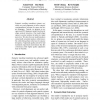245 search results - page 5 / 49 » Exploiting Syntactic Structure for Language Modeling |
EMNLP
2008
13 years 9 months ago
2008
Minimum-error-rate training (MERT) is a bottleneck for current development in statistical machine translation because it is limited in the number of weights it can reliably optimi...
APSEC
2003
IEEE
13 years 11 months ago
2003
IEEE
Today, the syntax of visual specification languages such as UML is typically defined using meta-modelling techniques. However, this kind of syntax definition has drawbacks. In par...
OOPSLA
2001
Springer
13 years 12 months ago
2001
Springer
The ability to extend a language with new syntactic forms is a powerful tool. A sufficiently flexible macro system allows programmers to build from a common base towards a langua...
NAACL
2010
13 years 5 months ago
2010
Syntactic machine translation systems currently use word alignments to infer syntactic correspondences between the source and target languages. Instead, we propose an unsupervised...
FM
2003
Springer
14 years 20 days ago
2003
Springer
Simple retrenchment is briefly reviewed in the B language of J.-R. Abrial [1] as a liberalisation of classical refinement, for the formal description of application developments ...

